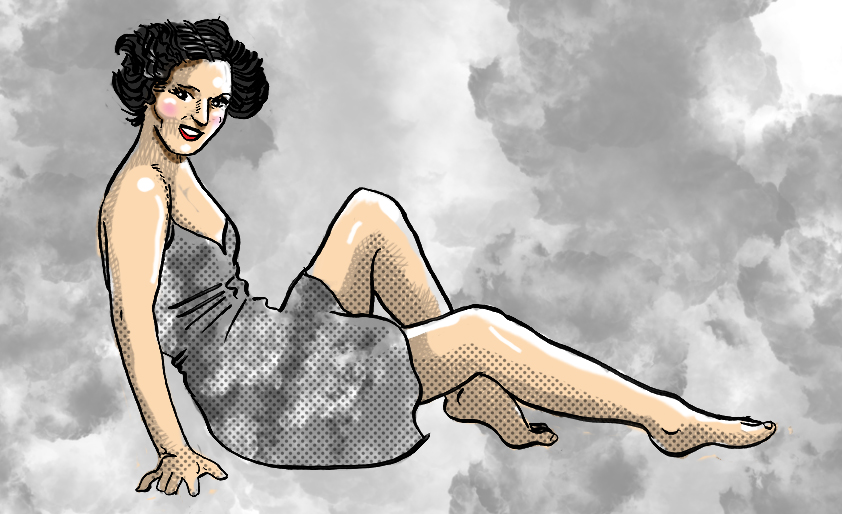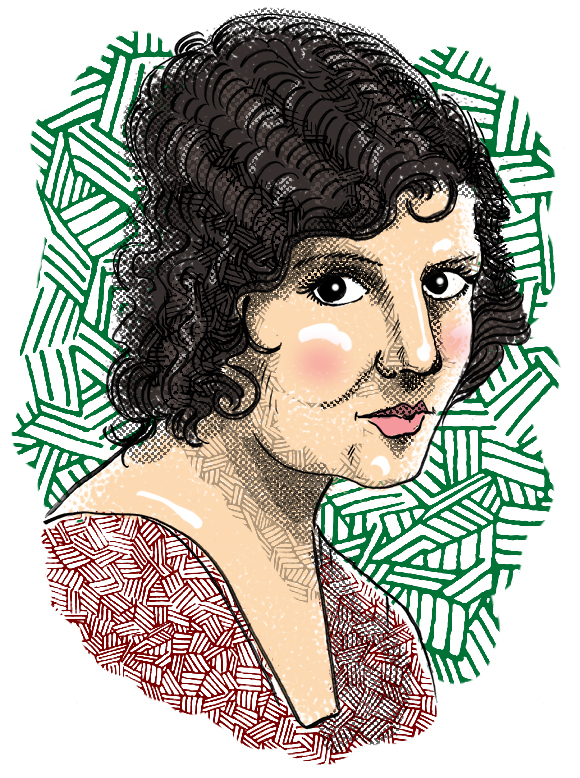DCS: dorothy short

Dorothy Short aspired to be an actress. She made her debut in 1935 starring alongside Noah Beery Jr. in the 12-part Universal Studios serial The Call of the Savage. Her next role was the one for which she is best remembered. In 1936, Dorothy was part of a cast of unknown actors and actresses tapped for a church-sponsored tale of morality entitled Teach Your Children. It attempted to show the dangers of drugs to impressionable youth. After filming was completed it was purchased by a commercial film distributor, re-cut, and released as Reefer Madness. The film was originally presented as an exploitation vehicle, but resurfaced in the 1970s as an unintentionally funny cult favorite. Dorthy married her Reefer Madness co-star Dave O’Brien.
She went on to appear in Assassin of Youth, another cautionary tale of drug addiction. After that, Dorothy focused on low-budget Westerns — both features and multipart serials. She signed with producer Pete Smith and made a number of comedy short subjects before divorcing O’Brien and retiring from show business in 1954. Dorothy passed away at the age of 47 in 1963.
Comments
inktober52: ball
Comments
DCS: judith love cohen
Judith Cohen was as smart as a whip. By the time she was in fifth grade, her classmates were paying her to do their math homework. Inspired by her natural ability with numbers, Judith set her sights on becoming a math teacher. She entered Brooklyn College on a math scholarship, but soon switched her major to engineering. While she was a student, she danced with the Metropolitan Opera Ballet company.
After completing two years at Brooklyn College, Judith married and moved to California, continuing her studies at USC at night, while working as a junior engineer for North American Aviation. She earned a bachelor’s degree and eventually a master’s degree in 1962.
As an engineer at Space Technology Laboratories (later TRW), Judith worked on the guidance computer for the Minuteman missile and the Abort-Guidance System in the Apollo Lunar Module. The Abort-Guidance System played an important role in the safe return of the troubled Apollo 13 after an oxygen tank explosion left the Service Module crippled. Fearing for their lives, astronauts were able to use the Lunar Module as a makeshift “lifeboat,” The Abort-Guidance System guiding the craft home to safety.
In 1969, Judith was working on a particularly puzzling problem with a schematic. She pored over her work, even taking a computer printout of the issue home with her. Judith was pregnant and expected to give birth at any moment. Undaunted, she worked diligently on the problem, finally calling her boss to report good news. She had solved the problem at hand and was now going into the delivery room. She gave birth on August 28, 1969 — to future actor/musician Jack Black.
With a career and family as a source of pride, Judith passed away in 2016, at the age of 82.
Comments
inktober52: river (part 1)
River Phoenix died of an accidental drug overdose on Halloween evening 1993… as his career was on a meteoric rise. His untimely death paused a number of projects in development in Hollywood.
- River was about to start filming his next picture in early November 1993. He had been cast to play “Daniel Molloy” in Interview with the Vampire. The role was recast with Christian Slater.
- River would have followed that role by playing Susan Sarandon’s son in Safe Passage. That role was eventually played by Sean Astin.
- He was signed to play the lead in John Boorman’s Broken Dreams. River’s death put the film on hold. It was resurrected in 2012, with Caleb Landry Jones taking over River’s role, but the film has yet to be made.
- River was in talks to play “Cleve Jones” in the award-winning biopic Milk. The role was taken over by Emile Hirsch.
- River was suggested to portray Andy Warhol in a proposed film about the late artist, but it never came to be.
- River loved the book The Basketball Diaries and hoped to one day play author Jim Carroll in a big-screen adaptation. The film was made two years after River’s death with Leonardo DiCaprio as Jim Carroll.
- River was interested in starring in Total Eclipse, in a role that subsequently went to Leonardo DiCaprio
- River was James Cameron’s first choice to play “Jack Dawson” in his epic film Titanic. Again, the role went to Leonardo DiCaprio.
- After his role as a young “Indiana Jones” in the prelude of Indiana Jones and the Last Crusade, plans were in the works to continue the film franchise with a series of prequel adventures with River in the lead role. His death put all development on hold until 2008 when Indiana Jones and the Kingdom of the Crystal Skull was released.
Comments
inktober52: river (part 2)
“I didn’t hear you say that. Because it isn’t possible. It’s inhuman to serve the same food, day after day. The Geneva Convention prohibits the killing of our taste buds! I simply cannot eat the same food every day! Fish! Liver! Day after day! I’ve eaten a river of liver and an ocean of fish! I’ve eaten so much fish, I’m ready to grow gills! I’ve eaten so much liver, I can only make love if I’m smothered in bacon and onions!”
— Hawkeye Pierce, after being offered liver or fish for eleven days in a row.
“Adam’s Ribs,” Season 3, Episode 11
M*A*S*H
Comments
DCS: wilma mankiller
The sixth of eleven children, Wilma Mankiller was born in 1945 in Oklahoma. Her father was a full-blooded Cherokee. Her mother was of Dutch and English heritage. Wilma grew up in her family’s ancestral home — without running water, electricity or telephones. In an act that echoed her family’s history, the Mankillers were moved to San Francisco under the federal government’s Bureau of Indian Affairs’ relocation policy. Wilma reflected upon this as her own “Trail of Tears,” referencing her paternal ancestors’ forced relocation under a similar governmental edict in the 1830s.
At 24, Wilma’s life was changed by the rebellious actions of group of Native Americans who took over the federal penitentiary on Alcatraz Island in San Francisco Bay and laid claim to it by ‘right of discovery’ to expose the suffering of American Indians. She was awakened to the mistreatment of Native Americans and dedicated her life to working for Native American rights. As director of the Oakland’s Native American Youth Center, Wilma personally fought for California’s Pit River tribe in its legal land battle with Pacific Gas and Electric.
In 1977, after a divorce, Wilma and her two daughters moved back to Oklahoma. She founded the Community Development Department for the Cherokee Nation. The organization campaigned for access to water and housing for Native Americans. She became a voice of the Cherokee Nation, working for better healthcare, housing and education. In 1985, she was elected Chief of the Cherokee Nation — the first woman to hold the esteemed position. Under her leadership, the Cherokee Nation flourished — including a budget that ballooned to $150 million annually from revenue from gaming, hospitality, natural resources and other Native American-operated businesses.
Wilma was named Ms. Magazine’s “Woman of the Year” in 1987. She was inducted into the Woman’s Hall of Fame in 1993 and was awarded the the Presidential Medal of Freedom from President Bill Clinton ion 1998. She was asked to contribute a pair of shoes to a Native American art exhibit. She sent an ordinary pair of shoes, saying these were the shoes she wore everywhere.
Wilma passed away in 2010 at the age of 64. Her funeral was attended by government officials, women’s rights activists, Cherokee Nation dignitaries and multitudes of people she had inspired.
Comments
inktober52: sidekick
Comments
DCS: marjorie daw

When her parents died, teen-age Marjorie House took over the responsibility to support her younger brother and sister. Taking the name “Marjorie Daw” from a popular children’s story, she pursued an acting career. With much determination, she was successful.
Marjorie appeared in 76 films between 1914 and 1929. Along the way, she had a brief marriage in 1923. In 1929, she married again, this time to Myron Selznick, a film executive and brother of producer David O. Selznick. When silent pictures fell of out of fashion with the popularity of “talkies,” Marjorie called it a career. She lived quietly and happily out of the spotlight until 1979 when she passed away at the age of 77.
Comments
inktober52: samurai
Before John Belushi, I wasn’t sure what a samurai was.
I’m still not sure.
